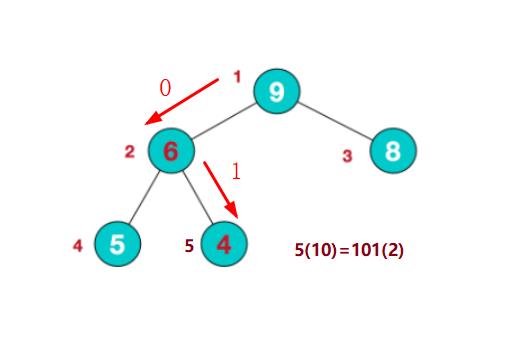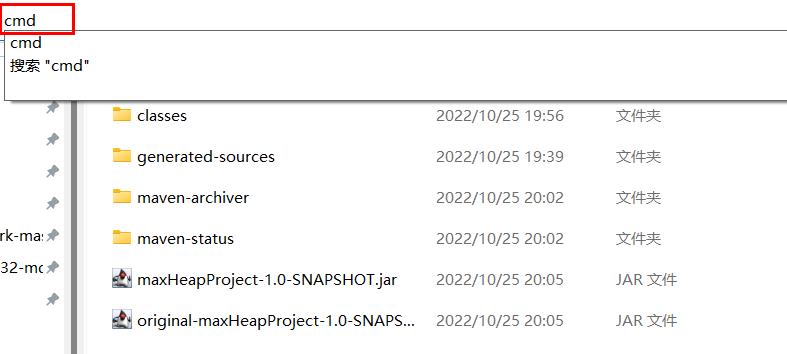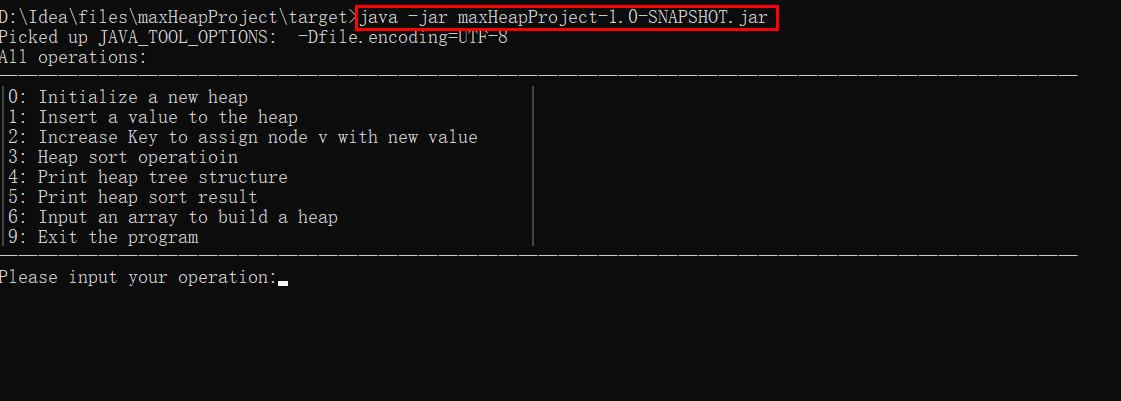堆相关知识复习(y总版)
我们本次预计使用Java来实现一个链式的大根堆,支持插入节点,修改节点值,堆排序,打印堆结构等功能。并将项目打包为jar包在cmd控制台运行。
1.功能设计
大根堆是一个完全二叉树,每个父节点的值大于两个子节点的值,那么要实现插入节点的操作,我们就需要知道从根节点插入所要经过的路径,以在节点5插入为例:

5的二进制表示为101,第一个1代表从根节点1开始,第二个0表示向左儿子走,第三个1表示向右儿子走,最终走到了节点5这里。这个找到插入节点路径的函数用getPath(x)实现。
数据结构设计
我们的每个堆中包括一个堆容量siz、堆二叉树∗∗head、数组sortedArray用于存储堆排序结果
每个堆二叉树节点包括节点值val,左右儿子编号left、right,父亲节点编号**fa
为了能够较为直观地打印出树,编写一个DefaultBinaryTreeNodePrinter和DefaultBinaryTreePrinter类用于树的打印。
堆排序,操作简单来讲就是将堆顶的元素拿出来,之后找到堆最后的一个元素的值getPath(堆的大小),用其替换堆顶元素的值,之后从堆顶开始执行下沉操作down(),同时堆大小siz−1,循环往复直到堆大小siz=0。
将排序好的结果存入数组sortedArray。
我们的堆支持一下几种操作:
- 0: 堆初始化
- 1: 堆中插入一个元素
- 2: 修改堆节点v的元素值为k
- 3: 堆排序操作
- 4: 打印堆的树结构
- 5: 打印堆排序结果
- 6: 输入一个数组构建堆
- 9: 退出程序
2.代码实现
先上C++代码(没有操作6和画树操作):
#include<bits/stdc++.h>
using namespace std;
struct node{
int val;
node *left;
node *right;
node *fa;
node(int x): val(x),left(NULL),right(NULL),fa(NULL) {};
node(int x,node *fa):val(x),left(NULL),right(NULL),fa(fa) {};
};
struct Heap{
int siz;
node *head;
vector<int> sortedArray;
string getPath(int t)
{
string s="";
while(t!=1)
{
int k=t%2;
s=(char)(k+'0')+s;
t/=2;
}
return s;
}
void up(node *root,string s,int idx)
{
if(idx==s.size()){
if(root->val>root->fa->val)
{
swap(root->val,root->fa->val);
}
return ;
}
if(s[idx]=='1'){
up(root->right,s,idx+1);
if(root->fa){
if(root->val>root->fa->val) swap(root->val,root->fa->val);
}
}
else{
up(root->left,s,idx+1);
if(root->fa){
if(root->val>root->fa->val) swap(root->val,root->fa->val);
}
}
}
void insert(int x){
if(!siz){
head=new node(x);
siz++;
}
else{
string s=getPath(siz+1);
head=insert(head,NULL,s,0,x);
siz++;
s=getPath(siz);
up(head,s,0);
}
}
node* insert(node *root,node *pre,string s,int idx,int x)
{
if(!root){
return new node(x,pre);
}
if(s[idx]=='1'){
root->right=insert(root->right,root,s,idx+1,x);
}
else{
root->left=insert(root->left,root,s,idx+1,x);
}
return root;
}
node* modify(node *root,string s,int idx,int x)
{
if(idx==s.size()){
if(x < root->val){
puts("Value k < key value!");
return root;
}
root->val=x;
return root;
}
if(s[idx]=='1'){
root->right=modify(root->right,s,idx+1,x);
}
else{
root->left=modify(root->left,s,idx+1,x);
}
return root;
}
void increaseKey(int v,int k)
{
if(v>siz)
{
puts("Node v not exist!");
return ;
}
else{
string s=getPath(v);
head=modify(head,s,0,k);
down(v,head,siz);
up(head,s,0);
}
}
node *copyHeap(node *a,node *b)
{
if(b)
a=new node(b->val,b->fa);
else
return NULL;
a->left=copyHeap(a->left,b->left);
a->right=copyHeap(a->right,b->right);
return a;
}
int query(node *root,string s,int idx)
{
if(idx==s.size()){
return root->val;
}
if(s[idx]=='1'){
return query(root->right,s,idx+1);
}
else{
return query(root->left,s,idx+1);
}
}
node *queryNode(node *root,string s,int idx)
{
if(idx==s.size()){
return root;
}
if(s[idx]=='1'){
return queryNode(root->right,s,idx+1);
}
else{
return queryNode(root->left,s,idx+1);
}
}
//下沉操作
void down(int x,node *root,int len)
{
//找到左右儿子中最大的数,替换父亲节点的值
int t=x;
if(x*2<=len && query(root,getPath(2*x),0)>query(root,getPath(t),0)) t=2*x;
if(x*2+1<=len && query(root,getPath(2*x+1),0)>query(root,getPath(t),0)) t=2*x+1;
if(x!=t)
{
node *a=queryNode(root,getPath(x),0);
node *b=queryNode(root,getPath(t),0);
swap(a->val,b->val);
down(t,root,len);
}
}
void output(node *root)
{
queue<node*> q;
q.push(root);
while(q.size())
{
int len=q.size();
for(int i=0;i<len;i++)
{
auto t=q.front(); q.pop();
if(t->left) q.push(t->left);
if(t->right) q.push(t->right);
cout<<t->val<<" ";
}
puts("");
}
}
void outputSortResult()
{
reverse(sortedArray.begin(),sortedArray.end());
for(auto x:sortedArray) cout<<x<<" ";
puts("");
}
void heapSort(Heap hp)
{
sortedArray.clear();
Heap temp;
temp.siz=hp.siz;
temp.head=copyHeap(temp.head,hp.head);
queue<node*> q;
q.push(temp.head);
//output(temp.head);
for(int i=0;i<siz;i++)
{
sortedArray.push_back(temp.head->val);
string s=getPath(temp.siz--);
temp.head->val=query(temp.head,s,0);
//int val=query(siz)->val;
//cout<<temp.head->val<<endl;
down(1,temp.head,temp.siz);
//output(temp.head);
}
}
Heap():siz(0){}
};
int main()
{
Heap h;
h.insert(5);
h.insert(6);
h.insert(7);
h.insert(1);
h.insert(2);
h.increaseKey(4,10);
h.output(h.head);
h.heapSort(h);
h.outputSortResult();
h.insert(15);
h.insert(25);
h.insert(36);
h.heapSort(h);
h.outputSortResult();
return 0;
}
Java代码另取
项目运行测试结果:

3.Maven项目导出jar包
我们新建一个Maven项目

之后找到项目的pom文件,输入一个maven-plugin-shade的启动依赖。
maven-plugin-shade必须和Maven构建生命周期中的package阶段绑定,也就是说,当执行mvn package时会自动触发shade。
我们的项目主类的路径为com.joy187.MaxHeap:

pom.xml
<?xml version="1.0" encoding="UTF-8"?>
<project xmlns="http://maven.apache.org/POM/4.0.0"
xmlns:xsi="http://www.w3.org/2001/XMLSchema-instance"
xsi:schemaLocation="http://maven.apache.org/POM/4.0.0 http://maven.apache.org/xsd/maven-4.0.0.xsd">
<modelVersion>4.0.0</modelVersion>
<groupId>org.example</groupId>
<artifactId>maxHeapProject</artifactId>
<version>1.0-SNAPSHOT</version>
<build>
<plugins>
<plugin>
<groupId>org.apache.maven.plugins</groupId>
<artifactId>maven-shade-plugin</artifactId>
<version>3.2.4</version>
<configuration>
<transformers>
<transformer
implementation="org.apache.maven.plugins.shade.resource.ManifestResourceTransformer">
<!--你的项目主类名称-->
<mainClass>com.joy187.MaxHeap</mainClass>
</transformer>
</transformers>
</configuration>
<executions>
<execution>
<phase>package</phase>
<goals>
<goal>shade</goal>
</goals>
</execution>
</executions>
</plugin>
</plugins>
</build>
</project>
刷新Maven项目后找到package并点击,进行打包操作

打包完成出现success字样:

4.cmd控制台运行项目
项目构建好后,我们找到target文件夹,里面不带有original的就是我们的可执行jar包了:

在该文件夹中输入cmd进入控制台:

控制台输入指令:
java -jar 项目名称.jar


